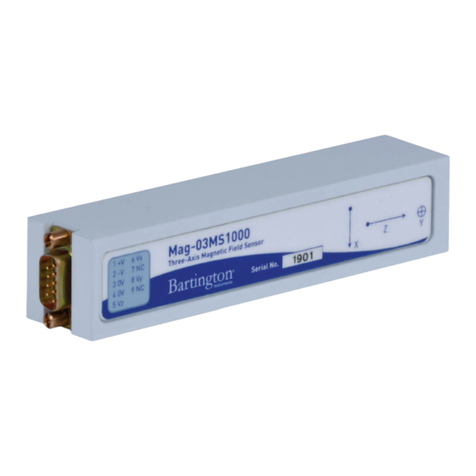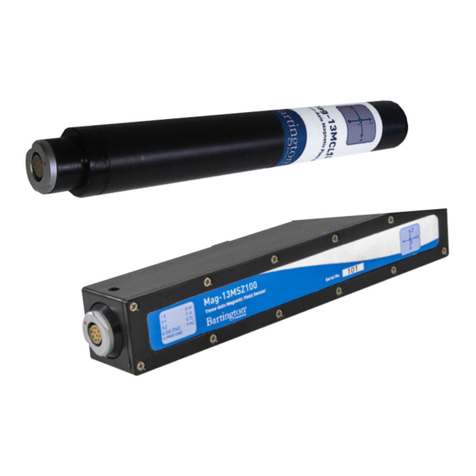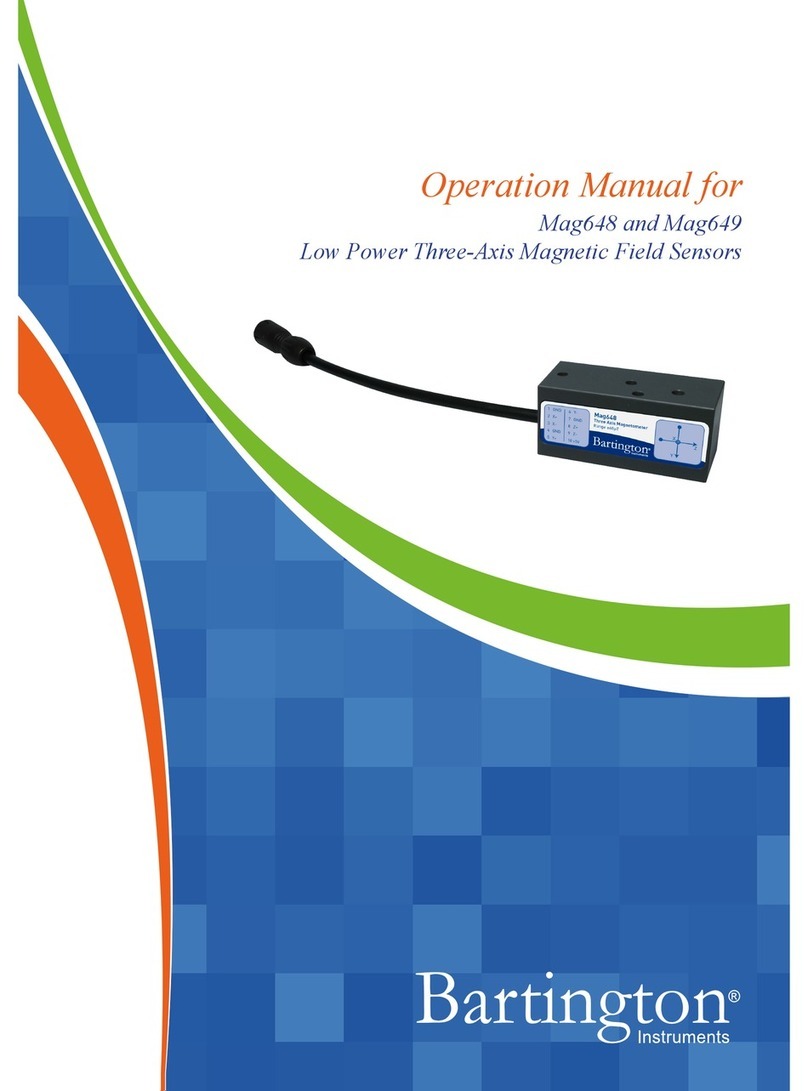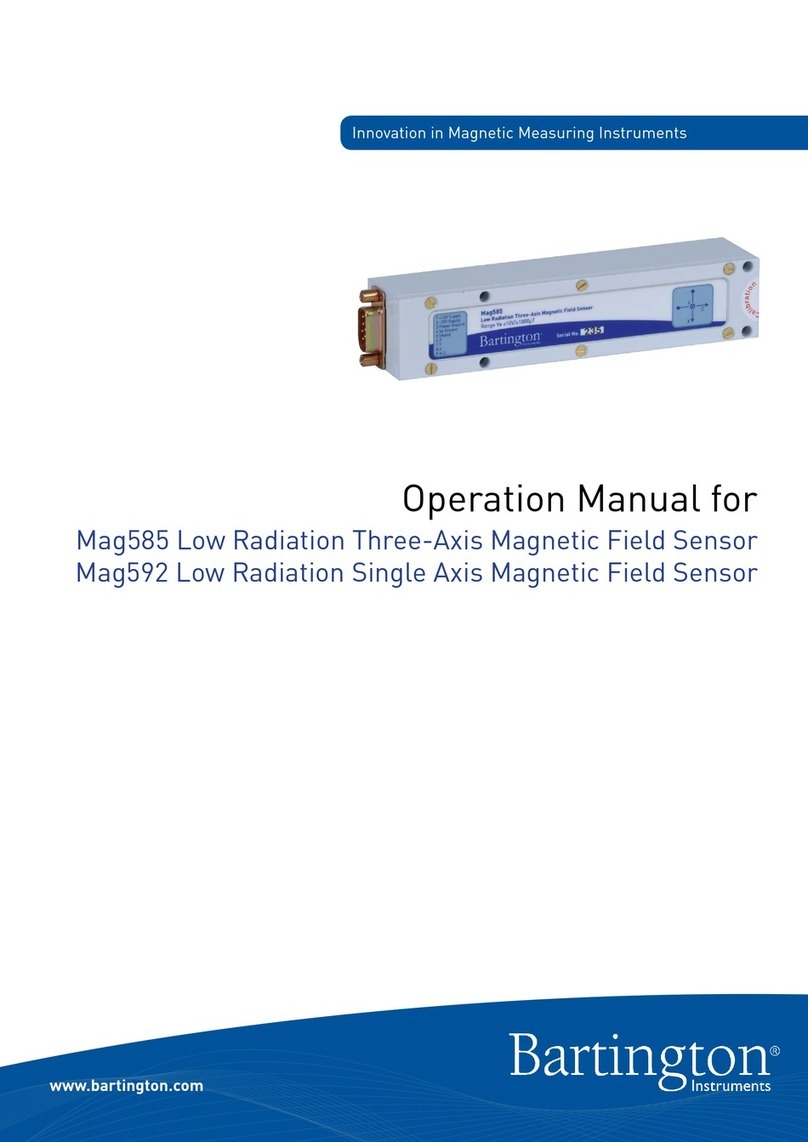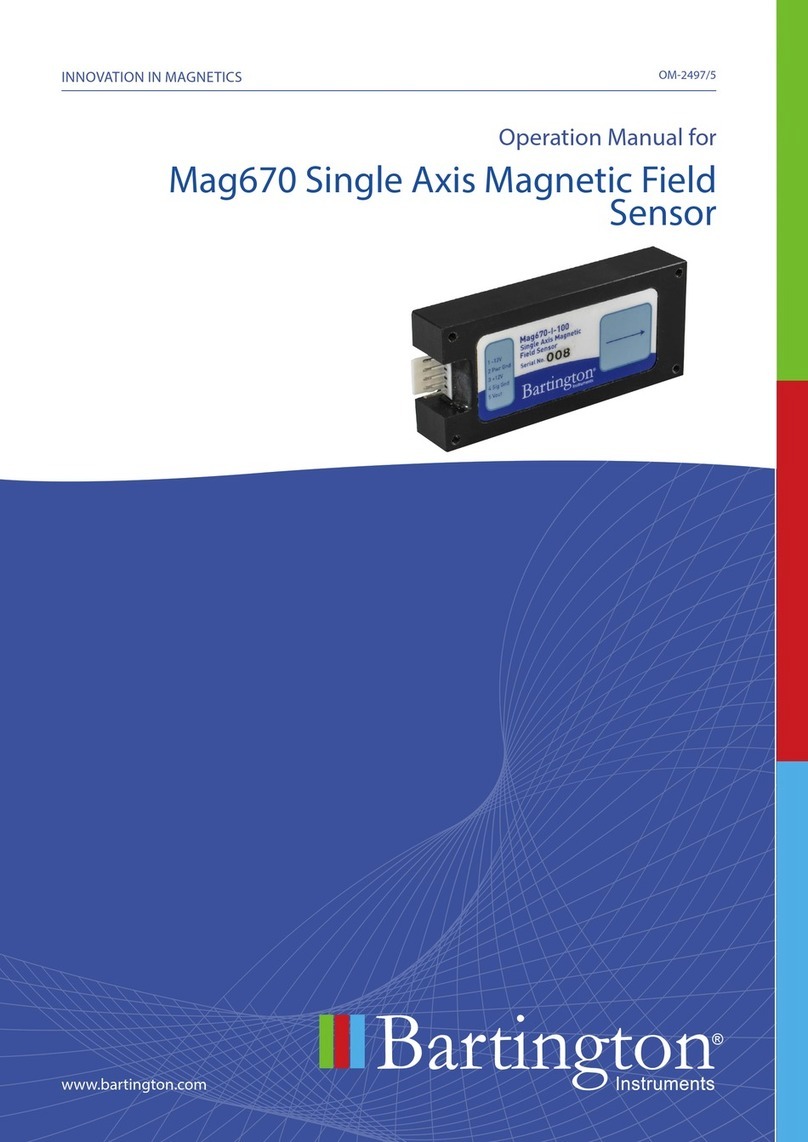Bartington Mag690 User manual

Operation Manual for
Mag690 Three-Axis Fluxgate Magnetometer

BARTINGTON INSTRUMENTS
Page 2 of 16 OM2604/3
Table of Contents
1. About this Manual 4
1.1. Symbols Glossary 4
2. Safe Use 4
3. Introduction to the Mag690 4
3.1. Vector Measurements and Conventions 5
4. Installing the Mag690 6
4.1. Siting the Magnetometer (Environment Recommendations) 6
4.2. Connection Recommendations 6
4.2.1. Connector Pin Allocation 6
4.2.2. Interface 6
4.2.3. Power Supplies 6
4.3. Pre-Installation Tests 7
4.4. Mounting Recommendations 7
4.5. Post Installation Testing 8
5. Using the Mag690 8
5.1. Cabling 8
5.2. Connecting Power 8
5.3. Response 9
5.4. Electromagnetic Compatibility 9
5.5. Performance 9
5.5.1. Signal Processing 9
5.6. Magnetic Hysteresis 10
5.7. Environmental Precautions 10
6. Troubleshooting 11
7. Care and Maintenance 11
7.1. Cleaning the Mag690 11
7.2. Calibration 12

BARTINGTON INSTRUMENTS
Page 3 of 16 OM2604/3
8. Storage and Transport 12
9. End of Life Disposal 12
9.1. Waste Electrical and Electronic Equipment (WEEE) Regulations 12
Appendix 1: Use of Alternative Power Supplies 13
A1.1. Signal/Power Ground 13
A1.2. Recommended Connection Method 14

BARTINGTON INSTRUMENTS
Page 4 of 16 OM2604/3
1. About this Manual
This manual describes the installation, operation and maintenance of the Mag690 Magnetic Field
Sensor. It should be read in conjunction with product brochure DS2604 and outline drawings
which can be found on the product page on the Bartington Instruments website at www.
bartington.com.
Note that failure to follow the instructions in this manual may invalidate your product’s warranty.
If in doubt, do not hesitate to contact Bartington Instruments.
1.1. Symbols Glossary
The following symbols used within this manual call your attention to specific types of
information:
WARNING: Indicates a situation in which serious bodily injury or death could result if the
warning is ignored.
Caution: Indicates a situation in which bodily injury or damage to your instrument, or both,
could result if the caution is ignored.
This symbol identifies items that must be disposed of safely to prevent unnecessary
damage to the environment.
Note: A note provides useful supporting information and sometimes suggests how to make
better use of your purchase.
2. Safe Use
WARNING: These products are not qualified for use in explosive atmospheres or life
support systems. Consult Bartington Instruments for advice.
Caution: To prevent irreparable damage, electrostatic discharge (ESD) protection and
precautions must be used when handling the unpackaged sensor electronics board.
3. Introduction to the Mag690
The Mag690 is a magnetometer consisting of a cluster of three feedback stabilised fluxgate
sensors arranged along X, Y and Z axes. Each axis provides a highly linear magnetic response
with low hysteresis and low cross talk between axes.
It is a cost effective sensor suitable for many general purpose applications. Fully encapsulated
construction ensures that the Mag690 can be used in the field as well as in a laboratory

BARTINGTON INSTRUMENTS
Page 5 of 16 OM2604/3
environment. High stability circuitry ensures that a minimum of ten years’ service should be
expected.
The sensor has no power supply or data processing abilities of its own and must always be
connected to a power supply to be able to function.
The flying lead cable supplied as standard with the Mag690FL enables the user to choose their
preferred connector.
The Mag690MX and Mag690U include low-cost connectors for users working in laboratories or
intending to fit the sensor inside their own enclosures.
The standard Mag690 has a pre-fitted circular connector rated IP67 for use in locations where
the sensor will be exposed to the elements.
3.1. Vector Measurements and Conventions
The magnetometer produces three independent analogue output voltages in response to the
magnitude and direction of the orthogonal components of a magnetic field. A ‘right-hand’ co-
ordinate system is adopted (Figure 1). In this system, the X, Y and Z axis correspond to the
thumb, first and second finger respectively of the right hand. By convention, the magnetometer
should be installed so that the X axis is arranged to point north, the Y axis to point east and the Z
axis to point down.
Figure 1. Illustration of the Right Hand Rule
North
+X
Thumb
Down
+Z
2nd Finger
East
+Y
1st Finger

BARTINGTON INSTRUMENTS
Page 6 of 16 OM2604/3
The centres of the three vector sensors are superimposed. Each orientation is denoted on the
magnetometer’s label. The point of each vector arrow indicates the positive direction of each
axis.
4. Installing the Mag690
4.1. Siting the Magnetometer (Environment Recommendations)
Note: Site the magnetometer several metres from any magnetic base rock to avoid
compromising measurements.
Note: Site the magnetometer several tens of metres from very large ferromagnetic objects
that could create fields exceeding the measuring range of the sensor.
Note: Avoid siting the sensor near any ferromagnetic objects that may be subjected to the
effects of magnetic hysteresis, which would affect the sensor in an unpredictable manner.
Note: Conduct a magnetic evaluation of any proposed installation site to establish that
it is free from magnetic contaminants. Carry out such an evaluation using total field or
resonance magnetometers.
4.2. Connection Recommendations
4.2.1. Connector Pin Allocation
The connector pin or cable colour allocation for the connection to each package type is shown on
the appropriate outline drawing on the product page.
Caution: When fitting your choice of connector to the Mag690FL, carefully follow any
instructions and recommendations issued by the connector manufacturer(s).
4.2.2. Interface
Diodes protect against reverse connection of power voltages of up to 40V. X, Y and Z outputs are
protected against short circuit to 0V.
Caution: Short circuits from output to either power rail may result in permanent damage to
the sensor. Limit the power supply current to 100mA to minimise risk of damage caused by
incorrect connection.
The analogue outputs for the X, Y and Z axes are buffered to give a low output impedance,
enabling the unit to be operated over long cables and interfaced to low impedance data
acquisition systems.
4.2.3. Power Supplies

BARTINGTON INSTRUMENTS
Page 7 of 16 OM2604/3
The Bartington PSU1, Magmeter, SCU1 and Spectramag-6 are ideal power supply units.
Alternatively, users may wish to provide their own power supply. Refer to Appendix 1 for further
information.
4.3. Pre-Installation Tests
The Mag690FL allows users to select their preferred connector.
Caution: Ensure any crimp terminals are the correct size for 7 x 0.2mm / 24AWG wire.
Prior to the installation of the system, the magnetometer, cable and power supply must be fully
tested to ensure correct function as follows:
1. Test the cables for continuity (using an electrical continuity tester or ohmmeter).
a. Test the cables end to end at the connectors to ensure that the correct pins have been
allocated to the conductors and that there are no open or high resistance circuits.
b. Test the cables at the connectors to ensure that there are no short circuits between the
conductors.
Caution: Take care to avoid bending or otherwise damaging the contacts whilst conducting
the tests.
Caution: Carefully check for correct connection before applying power. Applying incorrect
polarity or power to output connections may cause irreparable damage to the sensor.
2. Check the power supply output voltage using a voltmeter. Refer to the product brochure for
the required values.
Caution: Switch off the power supply before connecting to the Mag690.
3. Connect the magnetometer to the cable connector.
4. Connect the power supply to the other cable connector.
5. Switch on the power supply and wait until the magnetometer has stabilised. Refer to the
product brochure for warm-up times.
4.4. Mounting Recommendations
Each magnetometer has a set of mounting holes to allow attachment to a stable base or fixture.
Refer to the mechanical drawings on the product page for details.
The sensor can also mounted on the Bartington Instruments Mag-TA Universal Tripod Adaptor.
See product brochure datasheet DS3140, available from Bartington Instruments, for instructions
on how to do this.

BARTINGTON INSTRUMENTS
Page 8 of 16 OM2604/3
4.5. Post Installation Testing
1. Site the magnetometer and install the power supply and cabling.
2. Switch on the power supply and wait until the magnetometer has stabilised. Refer to the
product brochure for warm-up times.
3. Confirm no magnetic objects are moving in the vicinity.
4. Monitor the sensor outputs.
5. Confirm that the sum of the measured magnetic field vectors is similar to the expected local
earth field.
5. Using the Mag690
5.1. Cabling
Note: The connecting cable to the sensor should be an eight-core screened cable. Two
cores will be used for positive and negative power supply lines, three cores for output
signals, one core for signal common and one for power supply ground. The screen should
be connected to supply ground at the supply end only. The capacitance between cores
should be less than 200pF per metre. A cable with individually shielded cores should be
considered for long cable applications.
Note: Leads are susceptible to EM interference and should be screened wherever possible.
Note: The length of the cable is limited by the voltage drop in the power supply lines
and the capacitance between the cores. For this reason the cable should be limited to a
maximum length of 600 metres.
Bartington Instruments can supply cables for connecting the sensor to the PSU1, Magmeter,
SCU1 and Spectramag-6.
5.2. Connecting Power
Caution: Check that the polarity of the supply is correct. The power supply should
be connected to the sensor before the supply is energised as this prevents high
surge currents which could cause damage. Apply the positive and negative supplies
simultaneously, and avoid leaving the sensor connected to one polarity only.

BARTINGTON INSTRUMENTS
Page 9 of 16 OM2604/3
5.3. Response
The analogue output V, for any channel, is proportional to the axial component b of the total field
F. If qis the angle subtended between the direction of F and sensing axis of the fluxgate element,
then:
b = F cosq and V αF cosq
5.4. Electromagnetic Compatibility
Note: The Mag690 is not shielded for immunity from, or emission of, electromagnetic
fields. Any shield placed around the sensor will limit the bandwidth of the sensor response.
The emissions generated are at a low level with a primary frequency of 15kHz, being
the frequency of the energising field of the sensor. The sensor is required to respond to
magnetic fields within the specified frequency band.
Note: Ensure that the sensor is not operated in areas where a high electromagnetic field
exists, even if the frequency is above the bandwidth of the sensor, as false information may
appear due to aliasing. This effect is seen in data acquisition systems when the frequency
of sampling is lower than the frequency of the signal which is being sampled. It may
produce apparent signals at lower frequencies than the noise, which may be within the
frequency band of the sensor. Similarly, do not place the sensor near to any equipment
which may be affected by the fields produced by the sensor excitation.
5.5. Performance
5.5.1. Signal Processing
For different applications it may be necessary to process the signal from the sensor in different
ways.
a. In order to increase the sensitivity of the recording system it may be necessary to back-
off the earth’s field and amplify only the changes in the field from the current value. This
requires a high-pass filter, which could be a simple capacitively coupled arrangement or a
multi-pole filter to provide a steep roll off characteristic. These features are all present in the
SCU1 signal conditioning unit.
The output from all fluxgate sensors will contain noise from the driving electronics. For the
Mag690 this noise is at 15kHz, which is well above the bandwidth of the sensors. Where low
noise operation is required, a filter should always be provided to reject the noise which lies
outside the band of interest.

BARTINGTON INSTRUMENTS
Page 10 of 16 OM2604/3
b. When the sensor output is digitized, it may be necessary to include an analogue low-pass
anti-alias filter to prevent the creation of in-band noise by beating the 15kHz excitation with
the sampling clock of the digitizer.
The level of unwanted breakthrough at 15kHz has been minimized in the Mag690 but may
still cause an apparently raised noise level when sampled at low sampling frequencies
without further analogue filtering.
c. In applications such as surveillance and magnetic signature monitoring, it may be required
to remove both the DC standing field and all AC noise and pick-up above a set frequency. The
band of interest will be, say, 0.01 to 10Hz, and a band pass filter can be used to provide the
required signal.
The Magmeter and PSU1 power supply units, which can be used with all sensors, contain
three low pass filters with a -3dB point at 4.5kHz together with three high pass filters with a
-3dB point at 0.1Hz.
The SCU1 signal conditioning unit provides filters with independent control of the low and
high pass filter sections, together with offset and gain control for the output of each axis.
5.6. Magnetic Hysteresis
The Mag690 is designed to have an extremely low magnetic hysteresis. However, Bartington
Instruments recommends your magnetometer is not subjected to magnetic fields greater than
their stated measuring range for extended periods, as this could alter the DC offset. If this
occurs, the offset will exhibit drift as it returns to its original offset specification.
Caution: Subjecting the magnetometer to fields in excess of 2 x the nominal range may
cause inaccuracy in future measurements. Degaussing the magnetometer can reverse
such an effect.
5.7. Environmental Precautions
Refer to the product brochure for maximum environmental electrical and mechanical ratings.
Caution: Exceeding the maximum ratings may cause irreparable damage to your sensor.

BARTINGTON INSTRUMENTS
Page 11 of 16 OM2604/3
6. Troubleshooting
The sensor is unlikely to suffer any defects in normal use: no internal components are
serviceable. The most likely causes of failure, and their solutions, are detailed in the following
table.
In the event of any apparent malfunction beyond those described in the table below, please email
[email protected]om, or telephone the Bartington Instruments service team on +44 (0)1993
706565.
Cause of failure Solution
Power supply Check the power supply as detailed in Pre-Installation Tests.
Cables Check the cables as detailed in Pre-Installation Tests.
Power Input If no fault can be found in the power supply or cables, ensure
the cable length is not too long, causing excessive voltage drop
between the power supply and magnetometer. Refer to the
specifications defined in the product brochure.
Magnetometer No physical damage to the Mag690 can be repaired. Replace with
a new unit. For information about disposal of the damaged unit,
refer to End of Life Disposal.
7. Care and Maintenance
No repair or servicing is possible with the Mag690. For further information, refer to
Troubleshooting.
7.1. Cleaning the Mag690
Use water and mild soap to remove grime from external enclosures.
Caution: Do not clean the unpackaged Mag690U.
Caution: Never use chemicals, such as solvents, when cleaning the Mag690.
Caution: Take particular care when cleaning around electrical connections. Bent or
damaged pins may cause the magnetometer to malfunction.

BARTINGTON INSTRUMENTS
Page 12 of 16 OM2604/3
7.2. Calibration
Return the Mag690 to Bartington Instruments for calibration at the recommended intervals.
Refer to the Calibration Certificate for further details.
8. Storage and Transport
Your sensor is a precision electronic instrument and should be treated as such.
Note: Avoid exposing this instrument to shocks or continuous vibration.
Note: Store only within the temperature range specified in the product brochure.
Note: Do not expose this instrument to strong magnetic fields while being stored.
Note: If the instrument is left to stand for a long period of time, move it to prevent
magnetisation of the cores.
9. End of Life Disposal
This product should not be disposed of in domestic or municipal waste. For information
about disposing of your sensor safely, check local regulations for disposal of electrical /
electronic products.
For details of when to dispose of your magnetometer refer to Troubleshooting.
9.1. Waste Electrical and Electronic Equipment (WEEE) Regulations
This sensor complies fully with Restriction of the Use of Certain Hazardous Substances in
Electrical and Electronic Equipment (RoHS) and WEEE Regulations current at the time of
printing.

BARTINGTON INSTRUMENTS
Page 13 of 16 OM2604/3
Appendix 1: Use of Alternative Power Supplies
Bartington Instruments power supplies provide the most suitable methods for connecting to
and operating your sensor. If you have decided to use an alternative then the information in this
Appendix is important.
Caution: Failure to follow these instructions may result in incorrect sensor readings and in
some circumstances may cause irreparable damage to your sensor, power supply, or both.
Power supplies should normally provide ±12V. For the lowest noise applications, ripple in the
output should be in the mV region. The nominal current requirements are +45mA and -18mA
with an additional current in proportion to the measured field. The additional current is 1.4mA
per 100μT per axis and will be drawn from the positive or negative supply, depending on the
direction of the field.
The maximum output voltage swing from the sensor will always be less than the supply voltage.
In the temperature range -40°C to +70°C, and with an external load of 10kΩ, the maximum
output voltage will be less than each supply voltage by up to 2V. All parameters other than the
output voltage range remain unaffected for supply voltage changes in the range from ±8 to ±15V.
The current drain is independent of the power supply voltage and the unit will operate with
input voltages down to ±8V. As the output voltage swing is limited to 2V less than the supply
voltage, for a supply of ±8V the output will operate normally with any output between +6V and
-6V, representing a field of 0.6 of the full scale value in each direction. The scaling factor and
linearity will remain at the normal value up to this saturation point. The output will remain at
the saturation level if the field is increased beyond this point. Asymmetric supplies may be used
provided that the minimum and maximum voltages are not exceeded for either polarity.
A1.1. Signal/Power Ground
The two signal/power ground conductors are connected to a common point within the sensor.
The power supply common (power 0V) should be connected to only one of them, which becomes
the power ground. The other conductor becomes the signal ground and is used as the 0V output
from the sensor. Each signal is then measured between the X, Y & Z output conductors and the
signal ground output. In this way, the signal ground carries no power supply currents.
The minimum current in the power ground conductor is approximately 25mA. On long cables,
this will give rise to an appreciable potential difference between the power supply end and
the sensor end of the power ground conductor. The use of separate power and signal ground
conductors will ensure that this voltage is not included in the voltage measured between the
signal outputs and the signal ground.

BARTINGTON INSTRUMENTS
Page 14 of 16 OM2604/3
A1.2. Recommended Connection Method
Figure 2. Ideal connection method.
Key to Figure 2:
1 Sensor 5 Signal Ground
2 Host 6 Power Ground
3 Host Power Supply 7 Ground
4 Host Local 0V
Figure 2 illustrates the recommended connection method for users who do not wish to use
Bartington Instruments’ power supplies.
Note: Using this method is essential when using cables over 10m.
The schematic shows signal and power grounds separated at the Host end. The Host is fitted
with buffer amplifiers configured as Instrumentation Amplifiers (IA), which have two high
impedance inputs, one connected to X, Y or Z and the other to signal ground. An IA produces an
output that is the voltage difference of its input referenced to a local 0V. This 0V reference may be
significantly different to either of the two input voltages to the IA (indicated by VCM in Figure 2).
Consult the manufacturer’s data for the part chosen to ensure the common-mode range is not
exceeded.

BARTINGTON INSTRUMENTS
Page 15 of 16 OM2604/3
In this configuration there is a voltage drop due to the cable’s resistance along the power ground.
Typical current is 25mA and the resistance of a 100m 24 AWG cable is 5Ω, resulting in a drop
of 0.125V. Thus the reference point for the X, Y and Z outputs is 0.125V difference to the Host
0V, which is the source of power for the sensor. However, no current flows in the signal ground
conductor because the IAs have very high input impedance and no voltage is dropped in the 5Ω
resistance of either signal ground or X, Y and Z conductors.
Connecting sensors using this method means that the sensor outputs are accurately read by the
IAs, which then refer them accurately back to the 0V of the Host equipment.

OM2604/3
The copyright of this document is the property of Bartington Instruments Ltd.
Bartington® is a registered trade mark of Bartington Instruments Limited in the following countries:
United Kingdom, Australia, Brazil, Canada, China, European Union, India, Japan, Norway and the
United States of America.
Bartington Instruments Limited
5 Thorney Leys Business Park,
Witney, Oxford, OX28 4GE, England.
www.bartington.com
T: +44 (0)1993 706565
F: +44 (0)1993 774813
E: sales@bartington.com
Other manuals for Mag690
1
Table of contents
Other Bartington Accessories manuals
